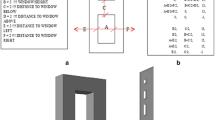Abstract
Many historic buildings were dismounted by natural or human actions. Archaeological studies focusing on this kind of buildings are based on in-depth analysis of on-site elements as well as fragments conserved in several places (sites, deposits, museums, etc.). This situation gives to virtual reconstruction the great interest of bringing back all the elements in the same space, thus allowing researchers to carry out a digital study of the building. Based on several surveying and representation techniques (3D laser scanning, photogrammetry, semantic structuring, image-based texturing, etc.), this research experience illustrates a complete methodology for the virtual assembling of dismounted architectures (from building parts to decoration elements) applied to the study of the Saint-Guilhem-le-Désert cloister, in France.

























Similar content being viewed by others
References
Boehler, W., Marbs, A.: 3D scanning instruments. CIPA WG 6 Int. Workshop Scanning Cult. Herit. Rec. 1, 7–11 (2002)
De Luca, L., Véron, P., Florenzano, M.: Reverse engineering of architectural buildings based on a hybrid modeling approach. Comput. Graph. 30, 160–176 (2006)
Nubes forma. http://www.map.archi.fr/nubes (2009). Accessed 27 Oct 2009
Tsai, R.: An efficient and accurate camera calibration technique for 3d machine vision. In: IEEE Conference on Computer Vision and Pattern Recognition, Miami Beach, pp. 364–374 (1986)
Duguet, F., Drettakis, G., Girardeau-Montaut, D., Martinez, J.-L., Schmitt, F.: A point-based approach for capture, display and illustration of very complex archeological artefacts. In: Proceedings of VAST 2004: the 5th International Symposium on Virtual Reality, Archaeology and Intelligent Cultural Heritage, pp. 105–114 (2004)
Abmayr, T., Hartl, F., Mettenleiter, M., Heinz, I., Heinz, A., Neumann, B., Frohlich, C.: Realistic 3d reconstruction. Combining laserscan data with rgb color information. In: Proceedings of ISPRS Internationational Archives of Photogrammetry, Remote Sensing and Spatial Information Science, vol. 35, pp. 198–203. (2005)
Dassault Systems Virtools. http://www.virtools.com (2009). Accessed 27 Oct (2009)
De Luca, L., Véron, P., Florenzano, M.: A generic formalism for the semantic modeling and representation of architectural elements. Vis. Comput. 23, 181–205 (2007)
Léon, J.-C.: Structure d’un environnement de conception multi-vues et multi-représentation. Actes des J. Model. Géométriques. Grenoble (1997)
Labrosse, D.: Le cloître de Saint-Guilhem-le-Désert et son évolution, du XIe au XIVe siècle. Archéologie du Midi medieval. 1–36 (2002)
De Luca, L., Bussarayat, C., Stefani, C., Véron, P., Florenzano, M.: An integrated framework to decribe, analyze, document and share digital representations of architectural buildings. In: Proceedings of VAST 2007: Futures Technologies to Empower the Heritage Professionals, Brigthon (2007)
Dudek, I., Blaise, J.-Y., Beninstant, P.: Exploiting the architectural heritage’s documentation: a case study on data analysis and visualisation. Proc. I KNOW Graz. 1, 128–134 (2003)
Acknowledgments
Authors want acknowledge: the Lapidary Museum of Saint-Guilhem-le-Désert; the “Cloisters—Metropolitan Museum” of New York; the Archaeological Society of Montpellier; Daniel KUENTZ (Le Désert Imaginaire); Géraldine MALLET (University Paul Valery Montpellier III); Hélène PALOUZIÉ (DRAC Languedoc Roussillon); Jean-Claude RICHARD (Maire de St Guilhem le Désert) for their help during the project. Chawee Bussarayat, Francesca De Domenico, Chiara STEFANI (MAP Laboratory) for their images.
Author information
Authors and Affiliations
Corresponding author
Rights and permissions
About this article
Cite this article
De Luca, L., Driscu, T., Peyrols, E. et al. A complete methodology for the virtual assembling of dismounted historic buildings. Int J Interact Des Manuf 8, 265–276 (2014). https://doi.org/10.1007/s12008-014-0224-5
Received:
Accepted:
Published:
Issue Date:
DOI: https://doi.org/10.1007/s12008-014-0224-5




